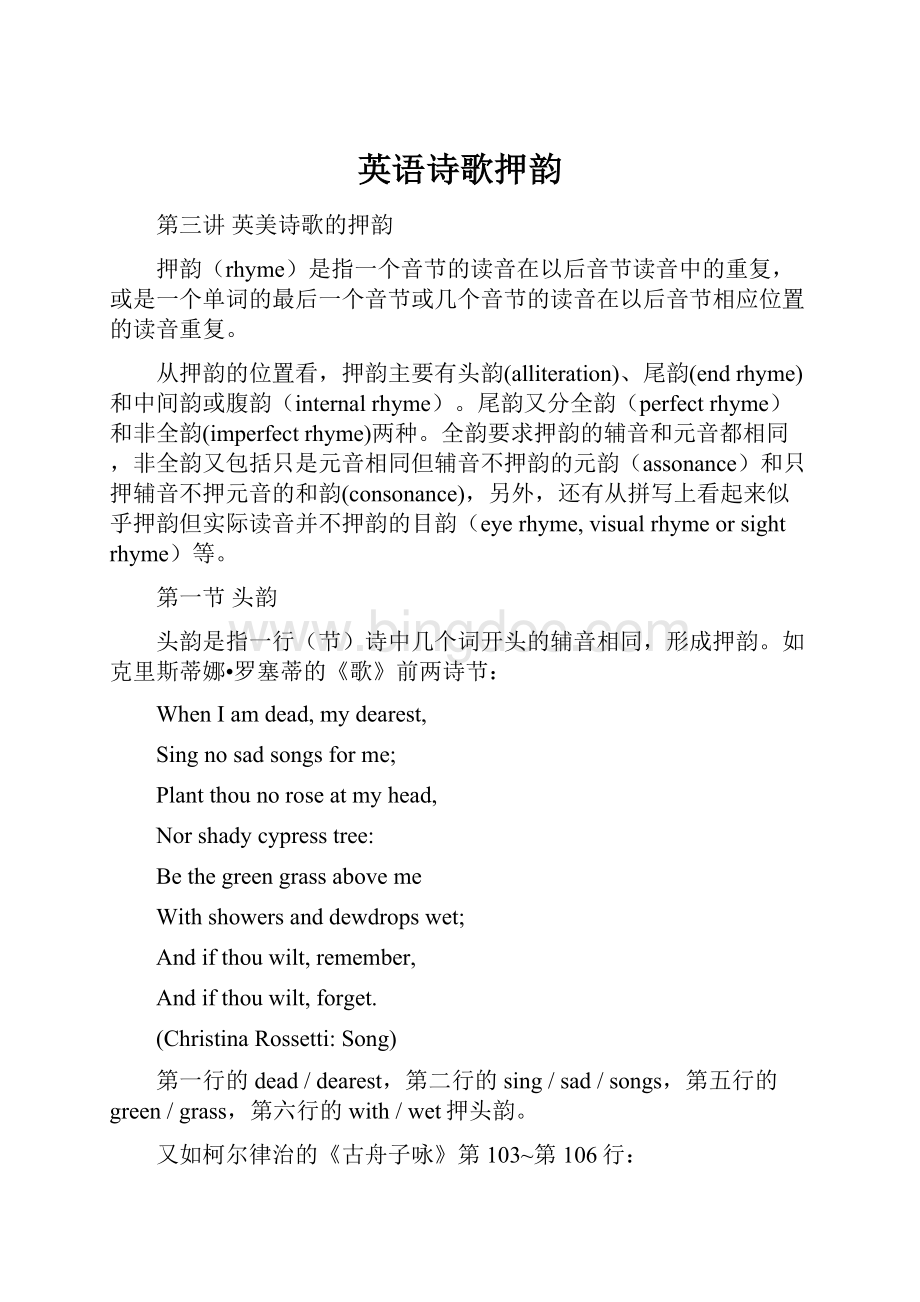英语诗歌押韵.docx
《英语诗歌押韵.docx》由会员分享,可在线阅读,更多相关《英语诗歌押韵.docx(13页珍藏版)》请在冰点文库上搜索。

英语诗歌押韵
第三讲英美诗歌的押韵
押韵(rhyme)是指一个音节的读音在以后音节读音中的重复,或是一个单词的最后一个音节或几个音节的读音在以后音节相应位置的读音重复。
从押韵的位置看,押韵主要有头韵(alliteration)、尾韵(endrhyme)和中间韵或腹韵(internalrhyme)。
尾韵又分全韵(perfectrhyme)和非全韵(imperfectrhyme)两种。
全韵要求押韵的辅音和元音都相同,非全韵又包括只是元音相同但辅音不押韵的元韵(assonance)和只押辅音不押元音的和韵(consonance),另外,还有从拼写上看起来似乎押韵但实际读音并不押韵的目韵(eyerhyme,visualrhymeorsightrhyme)等。
第一节头韵
头韵是指一行(节)诗中几个词开头的辅音相同,形成押韵。
如克里斯蒂娜•罗塞蒂的《歌》前两诗节:
WhenIamdead,mydearest,
Singnosadsongsforme;
Plantthounoroseatmyhead,
Norshadycypresstree:
Bethegreengrassaboveme
Withshowersanddewdropswet;
Andifthouwilt,remember,
Andifthouwilt,forget.
(ChristinaRossetti:
Song)
第一行的dead/dearest,第二行的sing/sad/songs,第五行的green/grass,第六行的with/wet押头韵。
又如柯尔律治的《古舟子咏》第103~第106行:
Thefairbreezeblew,thewhitefoamflew,
Thefurrowfollowedfree,
Wewerethefirstthateverburst
Intothatsilentsea.
(SamuelTaylorColeridge:
TheRimeoftheAncientMariner)
前三行里,头韵[f]重复七次。
这个摩擦送气的清辅音模仿柔风轻涛的声音,创造出一种宁静的意境。
第四行里的两个[s]音宛如和风吹过沉寂海面而发出的咝咝声。
头韵在这里的使用,令读者有身临其境之感。
另外,中间韵blew/flew,first/burst,furrow/followed,尾韵free/sea形成悦耳动听的韵味和节奏感。
再如莎士比亚编号为71的十四行诗前八行:
NolongermournformewhenIamdead
Thanyoushallhearthesurlysullenbell
GivewarningtotheworldthatIamfled
Fromthisvileworldwithvilestwormstodwell.
Nay,ifyoureadthisline,remembernot
Thehandthatwritit;forIloveyouso
ThatIinyoursweetthoughtswouldbeforgot
Ifthinkingonmewouldmakeyouwoe.
每行都有不同的头韵。
第一行为mourn/me,第二行为surly/sullen,第三行为warning/world,第四行为world/worm,第五行为read/remember,第八行为me/make和would/woe。
第二行、第三行和第五行为than/that/this,第七行和第八行为thoughts/thinking。
这样的不同首字母交替出现在一个诗节中,可以称为交叉头韵。
诗人在使用头韵时,还使用一种声音的重复,通过这种声音的重复表达一种独特的情感。
如多恩的《歌》:
Whenthousigh’st,thousigh’stnotwind
Butsigh’stmysoulaway;
Whenthouweep’st,unkindlykind,
Mylife’sblooddothdecay.
Itcannotbe,
Thatthoulov’stme,asthousay’st,
Ifinthinemylifethouwaste,
Thouartthebestofme.
(JohnDonne:
Song)
此诗节使用的头韵有when/wind/weep/waste,sigh/soul/say,doth/decay,blood/be/best,thou/then/that等。
另外,在sigh、kindly、thine、my和life中有频繁的元音字母i,此音暗示悲伤和抑郁,加上它是一个长元音,自然就减缓了诗行自然的快节奏运动,哀伤和抑郁之情得到了充分的表现。
同样的诗歌技巧也体现在爱伦•坡的《乌鸦》之中,如该诗的最后一节:
AndtheRaven,neverflitting,stillissitting,stillissitting
OnthepallidbustofPallasjustabovemychamberdoor;
Andhiseyeshavealltheseemingofademonthatisdreaming,
Andthelamp-lighto’erhimstreamingthrowshisshadowonthefloor;
Andmysoulfromoutthatshadowthatliesfloatingonthefloor
Shallbelifted–nevermore!
(AllanPoe:
TheRaven)
此诗节中除了各行的头韵(still/sitting,pallid/Pallas,his/have,lamp/light,from/floating/floor),还有内韵(flitting/sitting,seeming/dreaming等),贯穿整个诗节的短元音[i]、[æ],长元音[i:
]、[o:
]和双元音[əu]生动地传达出了主人公的痛苦和绝望。
第二节尾韵
尾韵(endrhyme)指行尾押韵单词最后的重读元音及其后面的辅音在读音上相同,而元音前面的辅音则不能相同。
也就是说,元音以及元音后面的辅音押韵,而元音前面的辅音则不押韵。
这种韵又被称为全韵(perfectrhyme)。
根据音节的数量,可分为单音节尾韵(singlerhyme)、双音节尾韵(doublerhyme)和三重音节尾韵(triplerhyme)。
单音节尾韵又称男韵或阳韵(masculinerhyme),是在诗行结尾重读音节之间出现的最普遍的押韵。
如米勒《在太平洋之滨》第二诗节:
Aboveyongleamingskiesofgold
Oneloneimperialpeakisseen;
Whilegatheredathisfeetingreen
Tenthousandforestersaretold.
Andallsostill!
Sostilltheair
Thatdutydropsthewebofcare.
(JoaquinMiller:
BythePacificOcean)
第一、四行押韵,第二、三行押韵,第五、六行押韵,都是重读单音节。
虽然是单音节押韵,但它只要求一个音节押韵,而不要求押韵的一个音节是一个单音节单词。
例如叶芝《走过柳园》第一节:
DownbythesallygardensmyloveandIdidmeet;
Shepass’dthesallygardenswithlittlesnow-whitefeet.
Shebidmetakeloveeasy,astheleavesgrowonthetree;
ButI,beingyoungandfoolish,withherwouldnotagree.
(W.B.Yeats:
DownbytheSallyGardens)
这里第四行的agree就是一个双音节单词,它只在第二个音节上与前行的tree押韵,而且它是重读音节。
双音节韵又称女韵或阴韵(femininerhyme),其基本特征是行尾单词最后两个音节押韵,其中倒数第二个音节是重读音节,而最后一个音节是非重读音节。
由于其读音是重读加非重读结构,因此它又称扬抑格韵(trochaicrhyme)。
如华兹华斯的《写于三月》前四行:
Thecockiscrowing,
Thestreamisflowing,
Thesmallbirdstwitter,
Thelakedothglitter.
(WilliamWordsworth:
WritteninMarchatBrother’sWater)
行尾的crowing/flowing,twitter/glitter相互押韵。
两组押韵都是由双音节单词组成,每个单词的第一个音节为重读音节,第二个音节为非重读音节。
又如丁尼生《女郎夏洛特》第一部分的第二诗节:
Willowswhiten,aspensquiver,
Littlebreezesduskandshiver
Throughthewavethatrunsforever
Bytheislandintheriver
FlowingdowntoCamelot.
Fourgreywalls,andfourgreytowers,
Overlookaspaceofflowers,
Andthesilentisleimbowers
TheLadyofShalott.
(AlfredTennyson:
TheLadyofShalott,PartI)
行尾的quiver/shiver/river,towers/flowers/imbowers相互押韵,除了imbowers,其余单词都是双音节单词,都是第一个音节为重读,第二个音节为非重读。
imbowers虽然是三个音节,但它的最后两个音节为重读加非重读,跟其余两个单词押韵。
这就是说,双音节韵的单词也可以是多音节单词,但其押韵的音节只能是两个,而且是多音节中最后两个音节。
同时,其结构也不能改变,是重读音节加非重读音节。
再如济慈《致一些女士》第一诗节:
Whatthoughwhilethewondersofnatureexploring,
Icannotyourlight,mazyfootstepsattend;
Norlistentoaccents,thatalmostadoring,
BlessCynthia’sface,theenthusiast’sfriend.
(JohnKeats:
ToSomeLadies)
这个诗节是单韵和双韵混合使用。
exploring/adoring都是三个音节,但重读音节在倒数第二个音节上,最后一个音节是非重读音节,因此它们押双韵。
在多音节单词中,如果最后两个音节押韵,但倒数第二个音节不是重读音节,也可以归入双韵。
如下面这首选自莎士比亚《凤凰与斑鸠》中的一段诗:
Beauty,truth,andrarity
Graceinallsimplicity,
Hereenclosedincinderslie.
Deathisnowthephoenix’nest;
Andtheturtle'sloyalbreast
Toeternitydothrest,
Leavingnoposterity:
--
’Twasnottheirinfirmity,
Itwasmarriedchastity.
Truthmayseem,butcannotbe;
Beautybrag,but’tisnotshe:
TruthandBeautyburiedbe.
Tothisurnletthoserepair
Thatareeithertrueorfair;
Forthesedeadbirdssighaprayer.
(Shakespeare:
“Threnos”ofThePhoenixandtheTurtle)
rarity/simplicity,posterity/infirmity/chastity都是三个音节或四个音节,它们在最后两个音节上都押韵,但倒数第二个音节都不是重读音节,虽不符合双韵的规定,非严格说来,也应该算双音节押韵。
另外,nest/breast/rest是标准的单音节押韵。
repair/fair/prayer这个押韵组中,repair虽是两个音节,但重读在第二个音节上。
air与ayer字母组合虽然不同,但读音相同,因此,三个单词押单音节韵。
三重音节尾韵是在双韵的基础上增加了一个音节,因此它可以被看成是双韵的变体。
押三重韵的英语单词在韵步上属于扬抑抑格,因此,三重韵有时也被称为扬抑抑格韵(dactylicrhyme)。
由于英语中符合三重韵规则的单词不多,因此三重韵可以由两个以上的英语单词构成,这种押韵被称为马赛克韵(mosaicrhyme),即几个单音节单词同一个多音节单词或几个单音节单词押韵。
如拜伦《唐璜》第一歌第二十二段后四行:
Idon’tchoosetosaymuchuponthishead,
I’maplainman,andinasinglestation,
But-oh!
Yelordsofladiesintellectual,
Informustruly,havetheynothen-peck’dyouall?
(Byron:
DonJuan,FirstCanto,XXII,Lines173~176)
intellectual有五个音节,其中lectual有三个音节,同下一行的peck’dyouall押三重马赛克韵。
第三节内韵
内韵,又称中间韵、行内韵、腹韵,指一行诗内的一个词语与同一行诗行尾的词语或另一行诗中的一个词语之间的押韵。
它不是在行尾的押韵,既可能与同一行诗中的词语押韵,也可能同下一行诗中的词语押韵,还可能同隔行诗中的词语押韵。
一行诗内的一个词语与同一行诗行尾的词语押内韵的例子,如雪莱的《云》,以第一诗节为例:
Ibringfreshshowersforthethirstingflowers,
Fromtheseasandstreams;
Ibearlightshadefortheleaveswhenlaid
Intheirnoon-daydreams.
Frommywingsareshakenthedewsthatwaken
Thesweetbudseveryone,
Whenrockedtorestontheirmother’sbreast,
AsshedancesabouttheSun.
Iwieldtheflailofthelashinghail,
Andwhitenthegreenplainsunder,
AndthenagainIdissolveitinrain,
AndlaughasIpassinthunder.
(PercyByssheShelley:
TheCloud)
单数行中的showers/flowers,shade/laid,shaken/waken,rest/breast,flail/hail,again/rain押内韵,它们都是行中间的词与同行尾词押韵。
该诗的其他诗节也是如此押韵,从韵律角度看,相当优秀。
另外,双数行行尾单词streams/dreams,one/Sun押单音节韵,under/thunder押双音节韵。
又如玛丽•伊丽莎白•柯尔律治的《女巫》第一诗节的前四行:
Ihavewalkedagreatwhileoverthesnow,
AndIamnottallnorstrong.
Myclothesarewet,andmyteethareset,
Andthewaywashardandlong.
(MaryElizabethColeridge:
TheWitch)
诗中第三行的wet/set押内韵。
该诗第二、三诗节的第三行分别是Myhandsarestone,andmyvoiceagroan和Shecame—shecame—andthequiveringflame。
其中的stone/groan和came/flame也押内韵。
既在一行诗内押内韵,又在隔行中押内韵的诗,爱伦•坡的《乌鸦》是典型例子,下面是该诗的第二个诗节:
Ah,distinctlyIrememberitwasinthebleakDecember,
Andeachseparatedyingemberwroughtitsghostuponthefloor.
EagerlyIwishedthemorrow;___vainlyIhadsoughttoborrow
Frommybookssurceaseofsorrow___sorrowforthelostLenore___
FortherareandradiantmaidenwhomtheangelsnameLenore___
Namelesshereforevermore.
(AllanPoe:
TheRaven)
第一行的remember/December以及第三行的morrow/borrow分别都是同一行内押内韵。
December/ember和borrow/sorrow属于一行诗的尾韵词同下一行诗中间的词押韵,两行诗不再押尾韵,这种结构的押韵叫隔行内韵(alternaterhyme)。
另外,第四行的lostLenore和第五行的rareandradiant押头韵。
《乌鸦》第三节第一、二行如下:
Andthesilken,sad,uncertainrustlingofeachpurplecurtain
Thrilledme___filledmewithfantasticterrorsneverfeltbefore.
《乌鸦》第五节后三行如下:
Andtheonlywordtherespokenwasthewhisperedword.“Lenore!
”
ThisIwhispered,andanechomurmuredbacktheword,“Lenore!
”
Merelythisandnothingmore.
在这些诗行中,thrilled/filled,whispered/murmured/word都是同一行诗中两个或三个词语押韵,但不押尾韵。
这种押韵被称为组合韵(sectionalrhyme)。
第四节元韵
元韵属于非全韵,指诗行中的元音读音相同,而元音前后的辅音则不同。
从押韵的位置来看,元韵可分为尾元韵和行内元韵。
尾元韵同普通尾韵不同。
尾韵要求行尾单词最后一个音节的元音和元音后面的辅音都要押韵,而尾元韵只要求行尾单词最后一个元音押韵,而不管元音后面的辅音是否押韵。
例如:
Sheseesthefallingleaves,thedyingleaves
Thatclingtherestill;above
Throughthebrownhorroroftheboughsshesees
Theempty,archingskull.
(E.L.Mayo:
Pool)
在这四行诗里,第一、三行最后单词中的元音字母ea和ee发音相同,第二、四行最后单词中的元音字母o和u也是发音相同,它们属于标准的尾元韵。
押元韵的诗行往往同押全韵的诗行一起组合成诗节,如狄金森《天堂,为我难以企及》第一诗节:
HeaveniswhatIcannotreach!
TheAppleontheTree,
Provideditdohopelesshang,
That"Heaven"is,toMe.
(EmilyDickinson:
HeavenIsWhatICannotReach)
第一行的reach和第二行的tree构成元韵,第二行的tree和第四行的me则构成全韵。
行内元韵指一行诗中相邻单词中相同元音的重复,这种重复也可以出现在几行诗中。
例如:
Skirtingtheriverroad,(myforenoonwalk,myrest,)
Skywardinairasuddenmuffledsound,thedallianceoftheeagles,
Therushingamorouscontacthighinspacetogether,
Theclinchinginterlockingclaws,aliving,fierce,gyratingwheel,
Fourbeatingwings,twobeaks,aswirlingmasstightgrappling,
Intumblingturningclusteringloops,straightdownwardfalling,
Tillo’ertheriverpois’d,thetwainyetone,amoment’slull,
Amotionlessstillbalanceintheair,thenparting,talonsloosing,
Upwardagainonslow-firmpinionsslanting,theirseparatediverseflight,
Shehers,hehis,pursuing.
(WaltWhitman:
TheDallianceoftheEagles)
这个诗节中,从开始到最后,元音[i]不断重复,第二行的sudden